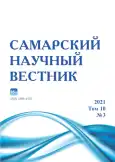Monitoring and prospects for conservation and rational use of the resources of the Eurasian beaver (Castor fiber Linnaeus, 1758) on the example of the Samara Region
- Authors: Antipov V.V.1, Dvornikov M.G.1
-
Affiliations:
- Professor Zhitkov Russian Research Institute of Game Management and Fur Farming
- Issue: Vol 10, No 3 (2021)
- Pages: 19-24
- Section: General Biology
- URL: https://journals.rcsi.science/2309-4370/article/view/90461
- DOI: https://doi.org/10.17816/snv2021103102
- ID: 90461
Cite item
Full Text
Abstract
The paper examines characteristics of the Eurasian beaver population (Castor fiber Linnaeus, 1758) on territories with different anthropogenic load. Monitoring the beaver population and habitat, including the landscape basis and natural zoning with the allocation of natural, natural-anthropogenic and anthropogenic territories as natural ecological systems allows you to manage and rationally use the resources of these animals. Previously there were mainly natural territories in the studied region, however with the growth of the human population and its economic activity their properties have changed. According to biotic criteria, geochemical circulation, significant (formerly natural) territories functionally already correspond to natural-anthropogenic and anthropogenic objects, since the supply of fodder, population density and density of animals have changed. According to natural zoning, taking into account the identified changes in the habitat of beavers (by biotic criteria), we have examined their territorial distribution as well as the number of settlements in various natural objects of the region. On the studied rivers the density of the beaver population in the channel decreases in the following order: natural territory → natural-anthropogenic → anthropogenic, but the indicator of private abundance (the density of animals on the territory where beavers live directly) and aggregation (crowding of individuals) increases. The population density of the river bed of the studied rivers by beavers on anthropogenic territories is from 0,9–3,7 individuals/km, which is lower than on natural and natural-anthropogenic territories, where this indicator is from 1,5 to 6 individuals/km. The length of the river bed, where beavers live directly, without taking into account significant buffer zones, varies in natural areas from 60 to 100%, which is more than in areas with anthropogenic load, where this indicator in the study area decreases to 40%. A decrease in the size of river channel sections suitable for beaver colonization leads to overcrowding (aggregation) of individuals. Compared with the total density of beaver population in the river channel 0,9–3,7 individuals/km of the channel (excluding the Kondurcha River – 6 individuals/km of the channel) the population density, locally, on anthropogenic and natural-anthropogenic territories increases to 4–7,5 individuals/km.
Full Text
##article.viewOnOriginalSite##About the authors
Vitaly Vasilievich Antipov
Professor Zhitkov Russian Research Institute of Game Management and Fur Farming
Author for correspondence.
Email: v.v.antipov@mail.ru
applicant of Hunting Resource Studies Department
Russian FederationMikhail Grigorevich Dvornikov
Professor Zhitkov Russian Research Institute of Game Management and Fur Farming
Email: dvornikov50@mail.ru
doctor of biological sciences, professor, leading researcher of Hunting Resource Studies Department
Russian FederationReferences
- Дежкин В.В., Сафонов В.Г. Научно-технический прогресс и охотничье хозяйство // Охота и охотничье хозяйство. 1986. № 1. С. 1–6.
- Перовский М.Д. Методы управления популяциями ценных охотничьих животных: автореф. дис. … д-ра биол. наук: 06.02.03. Киров, 1998. 23 с.
- Шварц С.С. Эколого-популяционные основы ведения охотничьего хозяйства // Труды междунар. конгресса биологов-охотоведов. М., 1970. С. 74–77.
- Кузякин В.А. Ландшафтное учение об охотничьих угодьях. М.: Товарищество научных изданий КМК, 2020. 400 с.
- Об охране окружающей среды: Федеральный закон от 10.01.2002 г. № 7-ФЗ (ред. от 25.06.2012).
- Атлас биологического разнообразия лесов Европейской России и сопредельных территорий. М.: МСОП, 1996. 144 с.
- Ходашева К.С. Динамика биомассы позвоночных животных и её связь с зональными особенностями фитомассы и водно-теплового режима // Биологическая продуктивность и круговорот химических элементов в растительных сообществах. Л.: Наука, 1971. С. 186–188.
- Мильков Ф.Н. Природные зоны СССР. М.: Мысль, 1977. 293 с.
- Виноградов Б.В., Орлов В.П., Снакин В.В. Биотические критерии выделения зон экологического бедствия России // Известия РАН. Серия географическая. 1993. № 5. С. 77–89.
- Дворников М.Г. Роль млекопитающих в таёжных и лесных экосистемах освоенных и охраняемых территорий Камского бассейна: дис. … д-ра биол. наук: 03.02.08. Тольятти, 2010. 482 с.
- Дворников М.Г. Млекопитающие в экосистемах бассейна реки Вятка (на примере особо охраняемых и освоенных территорий). Киров: Издательство ОАО «Киров. обл. тип.», 2007. 351 с.
- Дворников М.Г. Популяционные особенности поселений бобров средней части бассейна реки Вятка // Аграрная наука Евро-Северо-Востока. 2016. № 4 (53). С. 63–68.
- Корытин Н.С. Структурно-функциональный анализ популяций промысловых млекопитающих при антропогенных воздействиях: автореф. дис. … д-ра биол. наук. Екатеринбург, 2013. 40 с.
- Кавеленова Л.М., Прохорова Н.В., Федосеев В.А., Денисова А.Ю., Макарова Ю.В., Корчиков Е.С., Кузовенко О.А., Власова Н.В. К возможностям интеграции различных средств в мониторинге природных, антропогенно трансформированных и ревитализирующихся наземных экосистем // Экологическая, промышленная и энергетическая безопасность. Севастополь: Изд-во ФГАОУ ВО «Севастопольский государственный университет», 2020. С. 229–232.
- Сенатор С.А. Природное районирование Самарской области в работах различных исследователей // Самарская Лука: проблемы региональной и глобальной экологии. 2015. Т. 24, № 1. С. 6–37.
- Каледин А.П. Сохранение биоразнообразия охотничьих животных на принципах организации и экономики охотничьего хозяйства: автореф. дис. … д-ра биол. наук. 03.02.08. Киров, 2003. 23 с.
- Дьяков Ю.В. Бобры Европейской части Советского Союза. М.: Моск. рабочий, 1975. 480 с.
- Бобрецов А.В., Лукьянова Л.Е. Пространственное размещение красной полевки в ельниках Печеро-Илычского заповедника // Исследования эталонных природных комплексов Урала: мат. науч. конф. посв. 30-летию Висимского заповедника. Екатеринбург: Изд-во «Екатеринбург», 2001. С. 251–253.
- Вершинин В.Л. Экология города: учебное пособие. Екатеринбург: Изд-во Урал. ун-та, 2014. 88 с.
- Склюев В.В. Популяционный анализ лисицы обыкновенной (Vulpes vulpes) в биотопах Самарской области разной степени нарушенности: автореф. дис. … канд. биол. наук: 03.02.08. Тольятти, 2010. 20 с.
- Золина Н.Ф. Млекопитающие урбанизированных территорий среднего Поволжья на примере города Пензы: автореф. дис. … канд. биол. наук: 03.02.08. Пенза, 2012. 20 с.
- Броздняков В.В. Экология реакклиматизированной популяции бобра в условиях антропогенной нагрузки: автореф. дис. … канд. биол. наук: 03.02.08. Екатеринбург, 1998. 25 с.
- Об утверждении нормативов допустимого изъятия охотничьих ресурсов и нормативов численности охотничьих ресурсов в охотничьих: приказ МПР РФ от 30 апреля 2010 года № 138.
Supplementary files











